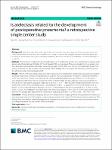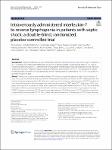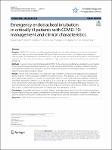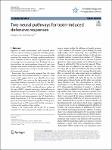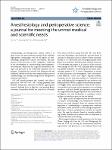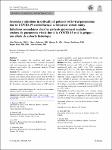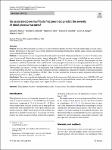Search
Author
- Daqing, Ma (3)
- Alexis, Ferré (2)
- Anna, Lybeck (2)
- Ashish K., Khanna (2)
- next >
Subject
- intensive care unit (8)
- acute respiratory dist... (5)
- chronic obstructive pu... (5)
- ICU (5)
- next >
Has File(s)
Search Results
Among patients undergoing elective non-cardiothoracic surgery, patients with postoperative atelectasis were associated with a 2.33-fold higher incidence of pneumonia and a longer LOS than those without atelectasis. This finding alerts the need for careful management of perioperative atelectasis to prevent or reduce the adverse events including pneumonia and the burden of hospitalizations. |
Intravenous CYT107 reversed sepsis-induced lymphopenia. However, compared to intramuscular CYT107 administration, it was associated with transient respiratory distress without long-term sequelae. Because of equivalent positive laboratory and clinical responses, more favorable pharmacokinetics, and better patient tolerability, intramuscular administration of CYT107 is preferable. |
Reasonable selection of intubation timing is particularly important, and no premature intervention or delay in intubation can reduce the oxygen debt of COVID-19 patients. In addition to the risk of hypoxia to the patient during intubation, there is also the risk of infection to the anesthesiologist directly exposed to SARS-CoV-2. Adequate and skilled intubation preparation and intubation are needed. The preparation of endotracheal intubation includes medical equipment, fasting and water-deprivation strategy, patient preparation (evaluating airway, etc.), self-protection of healthcare provider, etc. |
The researchers mapped the projections of AP neurons and found that excitatory and inhibitory AP neurons displayed different projection patterns. Excitatory neurons projected to many brain areas, including the parabrachial nucleus (PBN), nearby NTS, and autonomic motor nuclei, while inhibitory neurons formed connections with AP neurons themselves and partly with NTS neurons. Clusters 2 and 4 primarily projected to calcitonin gene-related peptide (CGRP) + PBN neurons, previously reported as alarm neurons [3]. These results revealed the possible circuit underlying nausea sensation. |
APS will mainly promote the research and clinical practice of “4B + 4P → 4S”. “4B”: raising questions from Bedside; doing basic research on Bench; applying the research findings back to Bedside, and gaining Better outcomes. Researchers should not come back to bedside from bench with bare hands, but with “4P”: new Products, new Procedures, new Protocols, and new Proof of concept for clinical practice to achieve “better outcome”, namely as “4S”: Save more lives; Save higher quality of life; Satisfy more patients; and Save more medical resources. APS welcomes any papers in all aspects of the research with concept of “4B + 4P → 4S”, especially those reaching the “golden endpoints” and meeting the yet unmet medical needs stated as“4S” as above. |
Sepsis is a syndromic response to infection and is frequently a final common pathway to death from many infectious diseases worldwide. The complexity and high heterogeneity of sepsis hinder the possibility to treat all patients with the same protocol, requiring personalized management. The versatility of extracellular vesicles (EVs) and their contribution to sepsis progression bring along promises for one-to-one tailoring sepsis treatment and diagnosis. In this article, we critically review the endogenous role of EVs in sepsis progression and how current advancements have improved EVs-based therapies toward their translational future clinical application, with innovative strategies to enhance EVs effect. More complex approaches, including hybrid and fully synthetic nanocarriers that... |
Secondary infections were common among critically ill patients with viral pneumonia including COVID-19. We found no difference in the incidence of SI between COVID-19 and influenza in our cohort study, but SI in patients with COVID-19 were associated with worse clinical outcomes and increased healthcare resource use. The small cohort size precludes any causal inferences but may provide a basis for future research. |
Latent tuberculosis (TB) infection has been known as a seedbed for TB disease later in life. The interruption from latent TB infection to TB disease can be done through TB preventive treatment (TPT). In Cambodia, only 40.0% of children under five years old who were the household contacts to bacteriologically confirmed TB cases were initiated with TPT in 2021. Scientific studies of context-specific operational challenges in TPT provision and uptake among children are scarce, particularly in high TB-burden countries. This study identified challenges in TPT provision and uptake among children in Cambodia from the perspective of healthcare providers and caregivers. |
The implications of an associated proximal fibula fracture in the setting of tibial plateau fractures has been examined in several reports [1, 5, 12, 14, 16]; however, there is a paucity of the literature describing their relationship to fracture classification and injury characteristics. This study aims to enhance our understanding of tibial plateau fractures and their relationship to proximal fibula fractures and meniscal injuries, to improve diagnosis, preoperative planning, and post-operative outcomes in these patients. |
With the surge of critically ill COVID-19 patients in China, numerous anesthesiologists from anesthesia intensive care units (AICU) or reallocated to other ICUs were devoted to the treatment of COVID-19. Besides the standard protocols to treat COVID-19 cases, anesthesiologists also have their own experience to treat COVID-19 cases based on professional expertise and practice. Here, we propose some viewpoints to treat critically ill COIVD-19 patients from the perspective of anesthesiologists. |

